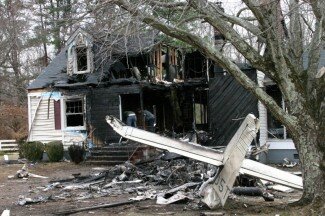Preliminary due: Report on fatal Louisa crash expected
A preliminary report pointing to possible causes of the fatal front-yard crash of a private plane in Louisa could be posted later this week, following National Transportation Safety Board policy.
"It's really day one of an investigation that takes about six months," said NTSB official Bob Gretz. "We're still in the fact-finding phase."
Gretz, a senior air safety investigator based in New Jersey, made his comments on site March 5, a day after the twin-engine Cessna Crusader crashed shortly after take-off from Freeman Field in Louisa, a town about 20 miles east of Charlottesville.
The pilot, identified as 62-year-old James "Jay" Youngquist of Reston, died in the fire, which consumed the one-and-a-half story Cape Cod-style residence near Jefferson Highway, better known as U.S. 33. A man inside the dwelling, who shunned a reporter's entreaty, had reportedly stepped into his basement moments before the front-yard crash, an act that allowed him to emerge unscathed. (Early accounts of the plane nosing into the house appeared to be incorrect.)
Gretz said that two workers at factory across the road separately commented that they noticed "grayish-blackish" smoke before the impact and that other witnesses reported the engines appeared to be "running rough."
A flight tracking service shows that Youngquist departed his home airport, Manassas Regional, that fateful day at 11:47am, maintained a 3,900-foot altitude and an approximately 195mph cruising speed, and arrived safely 20 minutes later at Louisa's Freeman Field.
The online log shows that shortly before landing, Youngquist swung the craft eastward around Lake Anna, where he had a home, as he lined up for his landing. Despite living in Reston, Youngquist had for several years volunteered as the secretary-treasurer of his beloved Lakeshore Woods, a 52-lot community.
A Fredericksburg news report indicated that Youngquist donated thousands of dollars worth of fuel and volunteered his time by flying around successful 2005 gubernatorial campaigner Tim Kaine, who expressed regret over the loss of his former pilot.
Another of Younquist's passions was baseball, and he was reportedly slated to umpire that day's 3pm baseball game between Hampden-Sydney College and Averett University, at the latter's diamond in Danville.
At Freeman Field, Youngquist himself filled the plane with 148 gallons of fuel–- which, Gretz noted, appears not to be faulty–- and took off from the western end of the runway. The first emergency responder was summoned, according to state police, at 12:34pm.
The FAA indicates that the airplane, tail number N9305T, was built in 1981 and had an air-worthiness certification in 2004. A map shows that the impact occurred just three fifths of a mile from the closest tip of the runway, which serves an average of 57 mostly-private flights per day.
Youngquist leaves behind his wife and three sons.

6 comments
Thank you for that fascinating analysis, sounds like you're a pilot that's navigated some tough situations --whatever happened here, this may have happened so fast that the pilot couldn't respond.
It is a complicated affair when one engine goes TU....especially at low altitude and at a critcal angle of attack. There is a lot to do in only a few seconds.
The NTSB will be investigating every aspect from maintenance, aircraft parts, to pilot currency/competency and in-depth witness interviews. They do an amazing job investigating and hopefully will contribute to the findings in a year or so.
Lousisa??? Come on, the hook, you can do better than that. Louisa is right next to us, the least you could do is spell it right on the headline. Whether it's a typo or ignorance, someone should have noticed that one before it was posted.
TKL is volunteering his services proof reading for the Hook.
Certainly sounds like a mechanical failure; how often do both engines shut down simultaneously ?--I would think this is very rare, but am not an aviation expert. Terrific in-depth report of this tragic event, Mr. Spencer. Clearly a wonderful man, and losing him will be a blow for many .
TJ,
Engine fire is different from engine failure (which I am assuming you call 'shutdown'). Engine fire is even more of an emergency situation compared to engine failure.
You are right, the changes of dual engine failure are rare. But the problem with twin engine piston planes is mainly a single engine failure. That's right, single engine piston planes are safer than twin engine piston, because if a single engine fails, you can glide the plane to a safe landing spot provided you are prepared (including good altitude). With a twin engine, if an engine fails, the thrust from the good engine will try to yaw the plane towards the dead engine, and the windmilling propeller of the dead engine (due to wind gust of 14mph from NTSB reports) could make the yaw worse and lead to a stall-spin (aerodynamic phenomenon when there is more airflow over one wing than the other).
Twin jet engine planes have crashed too due to this problem (eg: concorde, O'hare Chicago plane crash when an engine fell off). Assymetric thrust is deadly: it can bring the plane out of control...however, with using the technique like good-engine, good-foot, i.e pressing the rudder pedal to yaw the plane towards to good engine and feathering the propeller (i.e. changing the pitch - blade angles of the propeller) can help, but should be done immediately.
There is a patented control system with a sensor that detects the failure of an engine: this normally takes care of assymetric thrust: some planes have this but the old seminoles and beeches don't have that.
Engine fire/cockpit smoke is always a super emergency, and I would just try to land the plane asap.